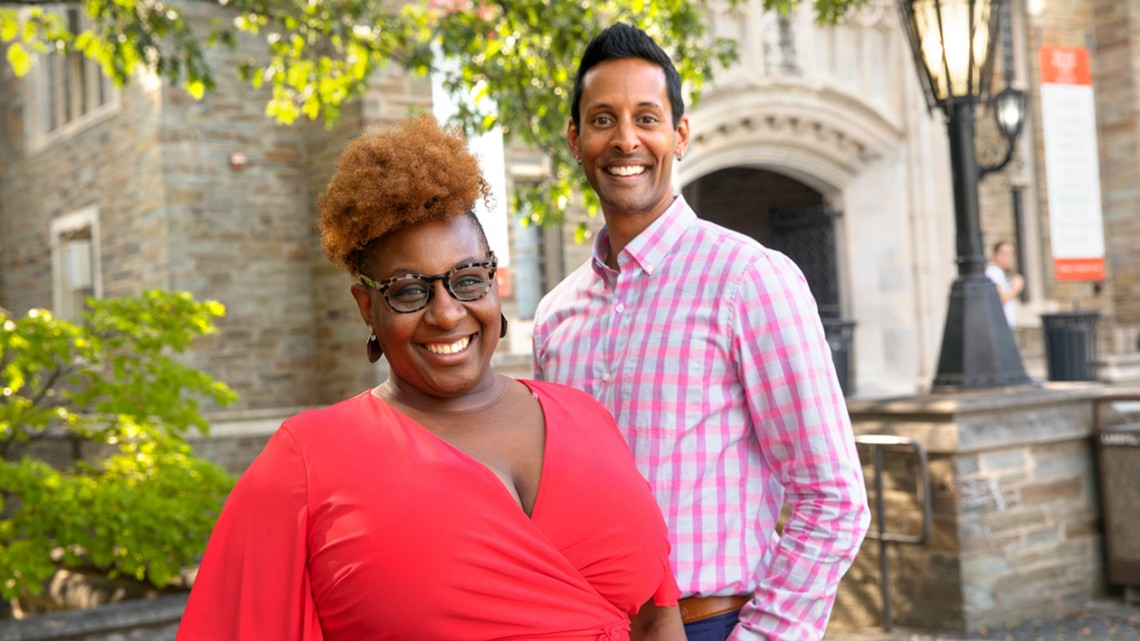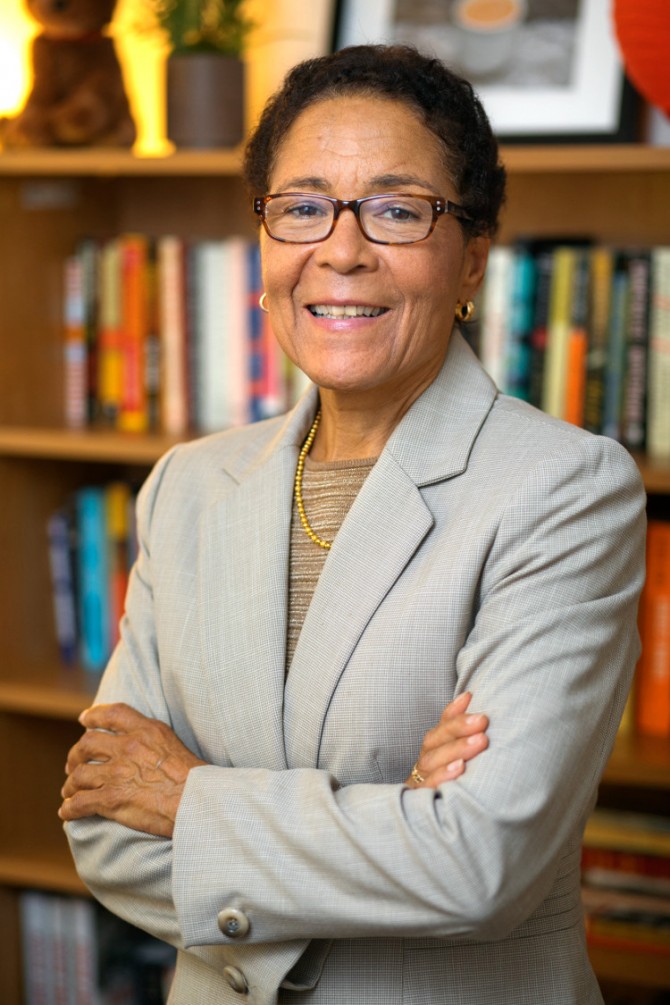
Marla Love and Vijay Pendakur outside Willard Straight Hall.
Leading by example: Creating a more inclusive campus community for students
By Melissa Shaffmaster
In fall 2017, Cornell’s Ithaca campus was rocked by two racially charged incidents. President Martha E. Pollack quickly responded in a statement to campus stating: “I will not tell you ‘this is not who we are,’ as the events of the past few weeks belie that. But it is absolutely not who we want to be.” She created the Presidential Task Force on Campus Climate and charged members of her leadership team to “develop and implement steps to be a more equitable, inclusive and welcoming university.”
One team leading the call to action is the Office of the Dean of Students, which provides resources and programming to strengthen the student community. Prior to the announcement, Vijay Pendakur, the Robert W. and Elizabeth C. Staley Dean of Students, had already begun prioritizing diversity and inclusion with the hire of Marla Love, senior associate dean of diversity and equity, and by shifting Renee Alexander ’74 into a new role as senior adviser on issues of campus climate. Over the past several months, the team has continued to grow with new positions in key support areas, including first-generation and low-income student services, veterans advocacy, undocumented and DACA student services, and peer-to-peer counseling and conflict resolution.
In August, Pendakur, Love and Alexander reflected on the campus climate and how changes to their office’s structure can help students find a sense of belonging at Cornell.
What are some of your biggest takeaways from the 2017-18 academic year?
Pendakur: One of the most amazing things was watching campus come together to really think about how to invest in resources and structures that support the student communities facing the biggest challenges at Cornell. Through generous contributions of the president, provost and alumni, we brought several new positions online that I believe will serve as tremendous resources and advocates for students. We also re-examined what student empowerment looks like.
How does a more diverse student population create a richer living and learning environment?
Pendakur: As Cornell continues to invest in greater diversity, we’re actually investing in a richer education for our students. When you’re working on a group project, if everyone in your group is exactly like you, I firmly believe that it impoverishes the educational experience. If we are able to approach problems with different sets of life experiences and worldviews, it opens up new possibilities for creation and invention.
Love: Having greater diversity in the campus community is only one piece of the puzzle. We need to think about creating intentional opportunities to explore diversity, talk about diversity, and think about opportunities that challenge and support students to connect across differences throughout every stage of their college experience.
What is “campus climate” for students and why is it important?
Alexander: Campus climate is really about how students navigate the institution, which includes perceptions and attitudes between and among groups on campus. This is a complex issue, and the influence of campus environments on the educational experience and academic outcomes of students can’t be overstated.
We have 20,000 students on campus representing a broad range of backgrounds and cultures. I believe the more we can get students into a room for activities and authentic conversations, where they can engage and build relationships, the more common ground we will find. We have a team of dedicated staff who are here to listen, to advocate and to honor each student’s background and experience.
What are some of the obstacles to improving campus climate for students?
Love: Not all students think that the phrase “diversity” includes them, but for us to improve the campus climate and truly embrace the value of a diverse campus, contributions are needed from everyone. As co-curricular educators, we have to find ways to talk about the responsibility each student has to reflect the values of Cornell – for students to truly value diversity and inclusion and to want to be part of creating a welcoming campus for everyone.
Pendakur: Another obstacle I see is the speed at which information moves through social media. I think it is important for students to recognize that part of the responsibility of the university’s leadership team is to balance speed with accuracy. That same responsibility does not exist in social media, which can make already painful situations even more frustrating or hurtful for students because of misinformation or a perceived lack of communication. Striking the right balance can be a real barrier to improving campus climate.
How does your office help students to feel supported?
Pendakur: We need to create spaces where students who have not historically been represented in large numbers in higher education can be their fullest selves. One of the most important ways we contribute to students’ sense of belonging and resilience is by providing them with those home bases where they can take the mask off and recharge their batteries so they can truly thrive.
Alexander: Our office can help students to explore difficult issues, and the more we give students a forum, the better off the university is going to be. Through meaningful dialogue and engagement, we involve students in programming designed to foster deeper understanding that helps to challenge assumptions about difference.
Love: I would add that it’s really important for our office to be visible to students so we can talk openly about how exploring identity or being part of various groups can be assets for students in the college environment. We are also a place of advocacy and support, and we want to use our resources and connections across the institution to bring student voices to the table. Another part of my role is to build a stronger connection with the Office of Academic Diversity Initiatives to work together to fill gaps between the curricular and the co-curricular.
What is one thing you think students might be surprised to learn about diversity and inclusion at Cornell?
Pendakur: Because Cornell is a big place, it is not always apparent how much significance is placed on diversity and inclusion and the scope of resources dedicated in every corner of the university. On the Ithaca campus alone, there are 50 people doing diversity and inclusion work, and I don’t think that most universities have that model or scale of support.
What guidance would you offer to incoming students?
Love: A student’s first days on campus and the amount of information shared during orientation can be scary and overwhelming. It is OK to take a step back and say, “Here is what I am concerned about.” If you can reflect on what is making you nervous or anxious, it can open up doors to finding the resources that make sense for you and will allow you to be more engaged in all of the opportunities that Cornell has to offer. In a way, the whole world has just opened up to you. Find a network, join a group, try a new activity – this is the college experience, and there are lots of people on campus who are here to support you along the way.
Melissa Shaffmaster is manager of strategic priority communications in the Office of University Communications.
Learn more about the new hires in the Office of the Dean of Students
- Love Odih Kumuyi, associate dean of students for peer-to-peer counseling and conflict resolution services
- Shakima Clency, associate dean of students for student empowerment and director of first-generation and low-income (FGLI) student support
- Kevin Graham, assistant director for undocumented/DACA student support
- Christopher Lujan, associate dean and director of the LGBT Resource Center
- Daniel Hoddinott, assistant director of the Cornell Asian and Asian American Center (A3C)
Media Contact
Get Cornell news delivered right to your inbox.
Subscribe

